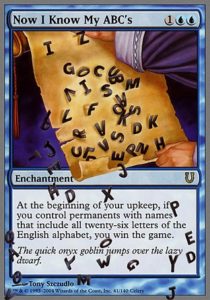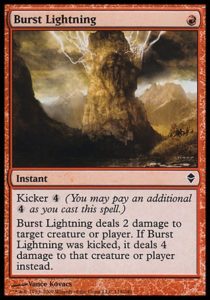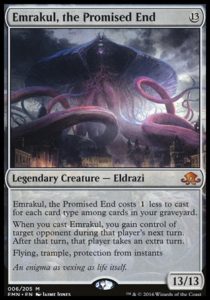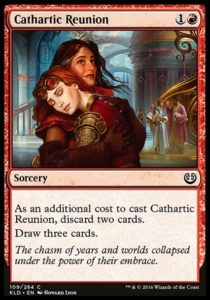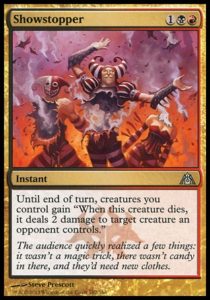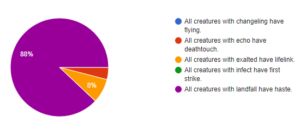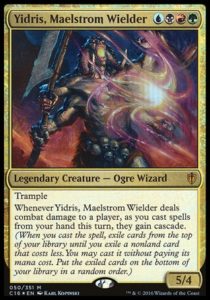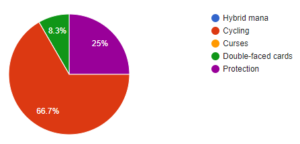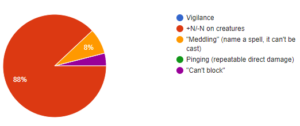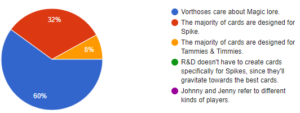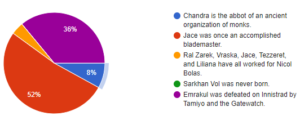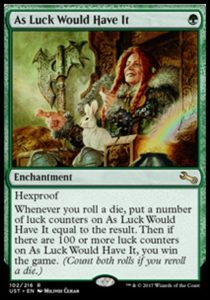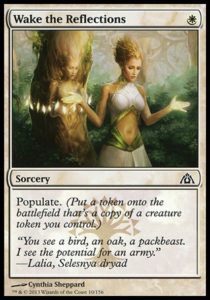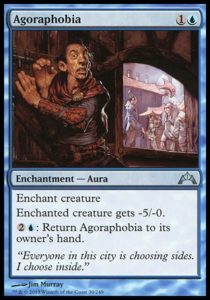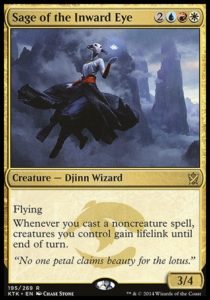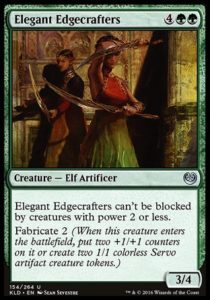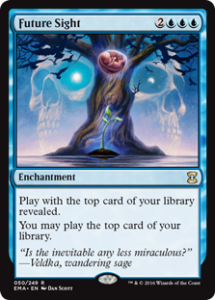This it it, the final challenge of Great Designer Training. GDS3 begins next week, so we’ve got one more week to practice. Here’s the form, you know the drill, so let’s do some design and go over last week’s challenges!
Callback Assignment: GDS2 Question 16
For our final callback question, I’m bringing back a straightforward one from GDS2.
16) Which mana cost is least appropriate for this card?
Mimsy Borogove
Creature – Human
2/2
a) 

b) 

c) 

d) 

e) 

Research Assignment: Recurring Template
There are several staple designs we see in Magic, touchstones that are revisited over and over again. The most well-known is probably Shock, which is powered up by a set-specific mechanic to do four damage. More recently, we’ve seen many Cancels with upside.
For this final assignment, find five different instances of recurring templates. For something to satisfy the (broad) definition of a template, you should have at least three examples for each template (since three is kind of the minimum necessary for a full pattern).
GDS-esque Questions
Question #1: Which color (or colors) is completely unable to untap creatures?
a) Blue
b) Black
c) Red
d) Green
e) Black and Red
f) Black and Green
g) Red and Green
h) Black, Red, and Green
i) None. All colors have some ability to untap creatures.
Question #2: Which is the most accurate statement about NWO (New World Order)?
a) New World Order is simplifying Magic to make it better.
b) New World Order is about making Magic easier for beginning players.
c) New World Order is about putting more power into uncommons, rares, and mythics.
d) New World Order is about limiting complexity at common.
e) New World Order began in Shards of Alara.
Question #3: Which of the following cards is not a color pie bend or break?
a) Augury Adept
b) Chaos Warp
c) Form of the Dragon
d) Sram, Senior Edificer
e) Vapor Snag
f) Vendilion Clique
Question #4: Which format does R&D not consider when designing sets?
a) Modern
b) Vintage
c) Commander
d) Pauper
e) Two-Headed Giant
Question #5: Vorthos question! Which of these cards is set on a plane which Magic has visited in a (non-core) expansion?
a) Horizon Canopy
b) Narcomboeba
c) Serra Sphinx
d) Segovian Leviathan
e) Warstorm Surge
Design Challenge
1: Romantic Love
Red is the color of emotion and passion, but we rarely see it depict emotions other than anger. Design a card that communicates the concept of healthy, consensual, romantic love.
2: Enchantments Matter
In 2020, Magic returns to Theros. Design a common with a new mechanic that involves enchantments in some fashion. (Note: the underlines are to emphasize restrictions that folks have often missed in this series. You really don’t want to miss such restrictions in GDS3.)
3: Supplemental Product
This is a bigger question than usual. Conceive of a supplemental product that does not yet exist. Who is the audience? What are three cards you would include? They can be reprints or new designs.
4: Devotion to Fixing It
Choose a mechanic from the past five years that was poorly received. Design a card with a better version of that mechanic.
5: Your Best Design
You’re in your GDS interview. They ask to see one card of yours, and only one, to evaluate you as a designer. You may submit something you’ve designed previously, or craft a new card. What card best shows off who you are as a designer and your unique insight.
Happy Designing!
You can submit all of your responses here. And now, let’s get to last week’s questions!
Callback Assignment: GDS2 Question 29
29) Which of the following enchantments are we least likely to print?
a) All creatures with changeling have flying.
b) All creatures with echo have deathtouch.
c) All creatures with exalted have lifelink.
d) All creatures with infect have first strike.
e) All creatures with landfall have haste.
All of these cards are problematic, but e is actually impossible to print. Landfall is an ability word (which has no rules meaning and cannot be tracked), whereas every other ability is a keyword. We even talk about that here a few weeks ago.
GDS-esque Questions
Question #1: Which of the following is not deciduous?
a) Hybrid mana
b) Cycling
c) Curses
d) Double-faced cards
e) Protection
Deciduous mechanics are like half-evergeen mechanics: any set is allowed to use them, but only when they need to, and so most don’t (and sometimes they’re used very sparingly, as with Infectious Curse). Protection looks like it should be the right answer, since it was retired as an evergreen keyword, but it wasn’t retired as a mechanic and is still deciduous.
Cycling has always been a major set mechanic (except for Time Spiral, which was a mix of everything), whereas every other mechanic has been stated to be deciduous.
Question #2: Which of the following is currently in blue’s color pie?
a) Vigilance
b) +N/-N on creatures
c) “Meddling” (name a spell, it can’t be cast)
d) Pinging (repeatable direct damage)
e) “Can’t block”
Every card that meddles is either blue and white or just white. Lately, with Nevermore and Gideon`s Intervention, the ability has been made clearly white. Marang River Prowler is a bend in blue (being unable to block is a black/red ability), so it sets a precedent. The correct answer is the Watecourser/Morphling ability, which blue has had forever. The question was trying to be a tiny bit sneaky (since black gives +N/-N to creatures, while blue creatures give themselves the bonus), but very few folks fell for it. Well done.
Question #3: Which is a true statement about the Magic psychographics?
a) Vorthoses care about Magic lore.
b) The majority of cards are designed for Spike.
c) The majority of cards are designed for Tammies & Timmies.
d) R&D doesn’t have to create cards specifically for Spikes, since they’ll gravitate towards the best cards.
e) Johnny and Jenny refer to different kinds of players.
This question has an embedded hint, since B and C are mutually exclusive. Jennies don’t require a ton of cards, since a few engines go a long way towards giving them means of expressing themselves, so the majority of cards have to be designed for either Spikes or Timmies. The answer comes down to Limited, where Spikes have a massive array of options to choose from and prove themselves with, whereas there are a very finite number of Timmy-focused cards in most sets (even in a Tammy-centric set like Ixalan). I’m not confident I’d have answered this question correctly if I didn’t follow Blogatog and Drive to Work.
Answer A was a trick, intended to test your knowledge of the psychographics. Mel and Vorthos are often discussed alongside the psychographics but they are not themselves psychographics. Tammy, Johnny, and Spike are ways of discussing why people enjoy the game, whereas Mel and Vorthos are about what they enjoy about the game. It’s a subtle difference, but a significant one. If you’re curious, you can read a very thorough explanation here.
Question #4: Lore! (I don’t expect GDS3 to go too in-depth on this, but you all aced last week’s lore question, so here we go.) Which is a false statement about Magic’s story?
a) Chandra is the abbot of an ancient organization of monks.
b) Jace was once an accomplished blademaster.
c) Ral Zarek, Vraska, Jace, Tezzeret, and Liliana have all worked for Nicol Bolas.
d) Sarkhan Vol was never born.
e) Emrakul was defeated on Innistrad by Tamiyo and the Gatewatch.
Magic tells stories in an unusual, atemporal medium. There’s no control over what order people see cards when they first open a booster pack, so sets need to communicate feel and major characters, whereas story beats often require scrutinizing many cards or reading a novel or short story in another medium. Even after the creature of the Gatewatch and a new era of character-centric storytelling, the subtle story beats were reserved for the more reliable medium of the written word.
To know the correct answer to this question, you either needed to do some research or be a rather dedicated Vorthos.
Chandra became the Abbot of Keral Keep in Offers to the Fire. That’s right, the classic red mage is in a position of authority in an ancient order.
Jace was partnered with a blademaster named Kallist Rhoka in Agents of Artifice. Kallist trained Jace to use a sword. They later switched minds, so not only was Jace in the body of (and believing himself to be) a blademaster, but a blademaster was in his body. Yup, Jace can use a sword.
Jace, Tezzeret, and Liliana all worked for Bolas in Agents of Artifice. Ral Zarek was revealed to be working for Bolas in Hour of Devastation. Vraska is working for Bolas in The Talented Captain Vraska. Everyone’s worked for Bolas at some point or other.
Sarkhan Vol discovered that he’d erased his own past in Unbroken and Unbowed. For all intents and purposes, he spontaneously sprang into existence when he first planeswalked away from Tarkir. I can’t imagine that that will have any repercussions.
The correct answer is E, because Emrakul won. You wouldn’t know it from the cards, but in The Promised End, Emrakul puppeted Tamiyo into sealing her into the moon (Tamiyo was trying to cast Planar Collapse, not Imprisoned in the Moon). Emrakul wasn’t ready yet (whatever that means), so she had Tamiyo put her exactly where she wanted to be.
Design Challenge: Lucky Spell
Design an uncommon sorcery with exactly seven words.
This was a tricky assignment, probably way more restrictive than something a Magic designer would have to do, but it was a fun and challenging exercise.
Druidic Edict by Nathan Whalen
1G
Sorcery
Target player sacrifices a nonland, noncreature permanent.
This is a powerful twist on Tribute to the Wild, able to hit planeswalkers but with weaker in multiplayer and at sorcery speed. Clean, powerful, and definitely an uncommon. Well done!
Casino Bouncers by Daniel Blees
1WW
Sorcery
Create three 1/1 white Human creature tokens.
I like it! Simple, powerful, but something I’m surprised we’ve not yet seen.
Lucky Charm by Luke Paulsen
U
Sorcery
Choose one–
– Untap target permanent.
– Proliferate.
– Scry 3.
I didn’t specify whether numbers counted as words (so I considered both Daniel Blees and Luke Paulsen’s designs valid). I definitely didn’t expect to see a charm for this assignment and am quite impressed with Luke Paulsen managed to squeeze into this design. It’s an appropriate charm (each effect is worth less than one mana) and isn’t clear what kind of deck it belongs in, but there are a lot of nifty options here. Great work!
Design Challenge: Minimalism
Design a rare creature with four words, none of which are keywords, ability words, or keyword actions.
Hilariously, I once again co-designed the most common answer to this question, or something close.
Ignorant Demon by Eric
1BB
Creature – Demon (R)
Skip your draw step.
6/6
Mulaak, Demon of Ignorance by Evan
{2}{B}{B}{B}
Legendary Creature — Demon
You can’t draw cards.
9/7
Crawling Ignorance by Jeremy Geist
2BB
Creature – Horror
You can’t draw cards.
6/6
Many people submitted creatures with downsides, but only three people submitted demons. I love that not only did they come up with the same core conceit, but that they managed to do it with different templating and different numbers.
Design Challenge: Acrophobia
Design an enchantment named Acrophobia.
There are many major cards that communicate fears or mental compulsions, but none have yet addressed fear of heights.
Acrophobia by Nathan Whalen
U
Enchanment – Aura
Enchant Creature
When Acrophobia enters the battlefield, draw a card and tap enchanted creature. Enchanted creature loses flying.
I like this design quite a bit as a Limited player: it’s Niveous Wisps with a small, but relevant and flavorful ability.
Acrophobia by Travis Froggatt
G
Enchantment–Aura
Enchant creature
Flash
Enchanted creature loses flying and can’t have or gain flying.
Acrophobia by borzilherbroot
U
Enchatment- Aura
Enchant Creature
Enchanted creature loses and can’t have or gain flying.
I’m not surprised that we saw several cards that involved flying, but I was pleasantly surprised to see two (almost) identical cards in two different colors. Both blue and green can make creatures lose flying and have done so recently.
Acrophobia by Bek
1UB
Enchantment – Aura Curse
Enchant Player.
Whenever one or more creatures with flying deal combat damage to enchanted player, enchanted player discards a card.
Acrophobia by Lance C
2B
Enchantment – Curse
Enchant Player
Whenever one or more creatures with flying deal combat damage to enchanted player, he or she discards a card.
The majority of designs communicate a creature becoming afraid of heights. Bek and Lance’s designs delightfully make your opponent afraid of them, instead. Whenever they’re attacked from on high, they freak out. I love it.
Design Challenge: Return to Tarkir
Magic returns to Tarkir. For the sake of flexibility, let’s say that both the Khans and Dragons timelines are viable to be returned to. Design a common with a new mechanic for one of the ten possible clans (wedge Khans clans or allied-color Dragons clans).
Acceptant Elder by Alexander Smith
2G
Creature – Human Warrior
T: Add W or B to your mana pool.
Heritage (When this creature dies, you may have target creature you control exile it. Creatures exiling this card have all activated abilities of this card.)
2/3
Oooh, a fix of Haunt! This feels like fairly restrictive design space (it has to go on creatures with activated abilities, but there are a lot of those), but that’s okay. I’d be intrigued to see ten cards with this mechanic (the Rootwalla ability, activated Deathtouch, and so on).
Jeskai Lorekeeper by Jeremy Geist
2U
Creature – Human Monk
When CARDNAME enters the battlefield, contemplate. (Reveal the top card of your library. Put that card into your hand if it’s not a creature or a land. Otherwise, return it or put it on the bottom of your library.)
2/2
Iiiiinteresting! It’s Explore for spells (and artifacts and enchantments)! This is a much weaker ability than Explore because setting aside the +1/+1 counter, you’re far less likely to find a noncreature, nonland card than a land. Still, I’m curious to see how it’d work in practice. It could be a cool deckbuilding restriction, or it could just lead to a lot of creatures with ETB: Scry 1 (which is a feel bad for most players who’d want to find spells, even if it’s all upside).
Sultai Ritualist by Lance C.
GUB
Creature – Naga Wizard
Ritualistic 2 (As you cast a spell, you may sacrifice this untapped creature. If you do, that spell costs 2 less to cast.)
When you sacrifice Sultai Ritualist, draw a card.
2/2
O…Offering? I admit, I didn’t expect to see this mechanic revitalized in any form. The restriction on Sultai Ritualist being untapped is a weird one and feel like Ritualistic would seem out of place in blue and be dangerous in high numbers. Still, it’s a very smart idea to combine Offering with Exploit to form a cost reduction mechanic like Delve.
Hidden Bolt by Matt Corkum
1R
Instant
CARDNAME deals 4 damage to target creature.
Spell Morph R You may cast this card facedown as a 2/2 colorless creature for 3. You may turn it face up at any time and exile it, then cast it for its Spell Morph cost)
This used to not be possible. It might still not be, and if it is, it might not be worth the complexity. However, Manifest made it so spells can be manifested onto the battlefield and not break the game by being flickered. I could see this as a Jeskai mechanic, though I feel it makes for really difficult play patterns. Playing a creature as a morph is a decision that’s mostly about mana efficiency with a little bit of trickery (but you’re getting the same kind of thing and can ultimately get the full creature). Playing a spell as a morph means you’re getting something completely different, which might be giving players an additional option where they don’t need one. In this case, you almost always want to cast Hidden Bolt. If you don’t play it with a mana up, you run the risk of it getting bolted, and if you wait until T4, you probably don’t want to play it into your opponent’s board. This design makes me wonder: what are spells that could make good spell morphs? Maybe really expensive spells that you discount by paying in installments? But then it feels awful when you lose them (and then players are walking around with a bunch of powerful effects). Really weak spells? Then why are you putting them in your deck? I really like the impetus here, but I wonder whether there’s much fun design space for this mechanic.
Design Challenge: Evasion
Design a creature with a form of evasion never seen before.
Chronomite by Jeremy Geist
U
Creature – Elemental
CARDNAME gets +4/+4 and can’t be blocked during extra turns.
1/1
Oh, it’s so niche and Jenny. I love it. It’s basically trinket text, but a card like this will make some players very excited.
Ugin’s Skulker by Jack S
1B
Creature – Spirit
Devoid.
Ugin’s Skulker cant’ be blocked by face-up creatures.
2/1
Narratively, there’s a lot going on in this card (it’s a black, Ugin-associated card with an Eldrazi ability for a set with morph). The ability itself is something I’m a little surprised we’ve never seen on a single card. The play pattern is a little weird and counterintuitive—it looks like it’s designed to trade with a morph, but the blocker can always unmorph and eat it. I’d be interested to see how that ability would play in a format like Khans or Dragons of Tarkir.
Dimir Skulker by James Gover
1UB
Creature – Human Rouge
Lurk (Dimir Skulker can’t be blocked by creatures with a larger converted mana cost)
3/2
A twist on Skulk, except there’s no way to interact with it. Magic has coalesced around evasion mechanics that either are evergreen or are like Skulk and Daunt (can’t be blocked by creatures with power 2 or less), which are relatively easy for a deck with creatures to answer. We’ve seen Landwalk and Intimidate retired in favor of Menace (which plays better and doesn’t shut off against certain colors of decks). I really have no idea how to evaluate Lurk except to see how it plays. It seems like a nifty mechanic for sure.
Sanity Consumer by Travis Froggatt
4UB Creature–Horror
Sanity Consumer can’t be blocked unless defending player exiles the top six cards of his or her library.
6/6
Several people submitted punisher or rattler designs, but Travis created my favorite for this assignment. I think this ability works because Awesome Presence works. I like how this is just a big, dumb creature that mills for 6 when it dies, but it presents itself in a much more dangerous light.
I’m still reading over everyone’s essays, so I’ll likely push essay reviewing into next week’s article where I’ll conclude this series an hour or so before GDS3 begins.
I want to thank every who’s participated in GDT, read about it, and even critiqued it. I’ve endeavored to make this the best experience I can in what free time I have available and have endeavored to incorporate all the feedback I’ve received. I applaud every single person who’s submitted for their courage and creativity and hope that we all end up competing against each other in the finals.
And, as always, thanks for reading!
—Zachary Barash
Zachary Barash is a New York City-based game designer. He works for Kingdom Death: Monster, has a Game Design MFA from the NYU Game Center, and does freelance game design. When the stars align, he streams Magic.
His favorite card of the month is Enter the Unknown from Rivals of Ixalan. It’s Explore, with Explore, but not in its name, and a touch more random.

